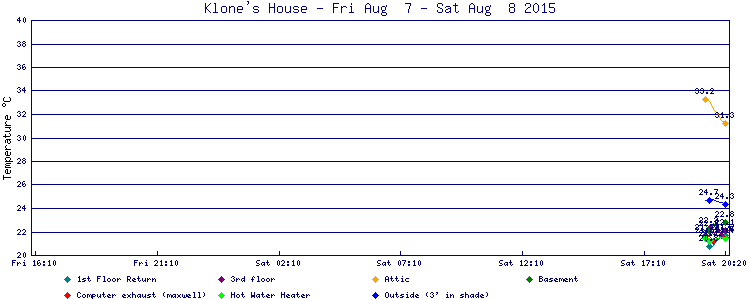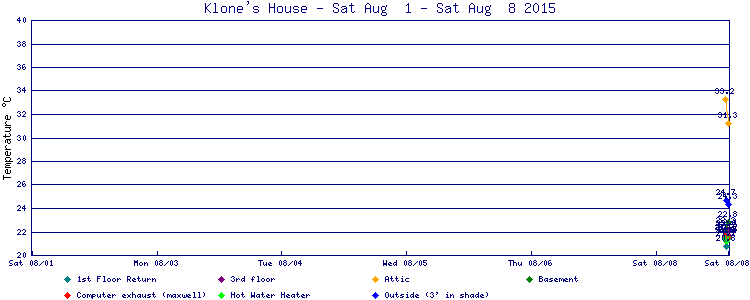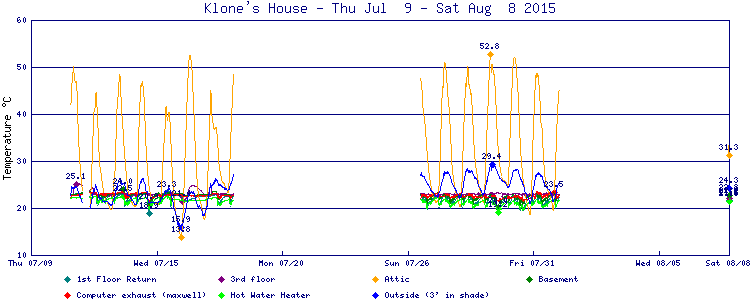home |
history |
downloads |
supported devices |
comparisons |
special sensors |
enersure |
graphs |
changelog |
to-do |
links |
support |
book |
contact
|
contact
Temperature, Power & Environmental Monitoring
|
 |
Now that many people have broadband, even if you do not have a static IP
address (with a little free help from
dyndns.org),
it is easy to have your house's status available to you when away from home.
Great for checking that the boiler is working properly in winter when
pipes might freeze, or for ensuring that your refrigerator is keeping the
beer cold. My system supports an ever-widening variety of sensors and data
collectors, can alert you to "unusual" conditions (via email, pager, or
syslog), and can even save you money!
Find out how often your furnace or A/C is running, find out is the basement
is flooding, if your computers are running hot, etc...
The software that logs the data and generates these
graphs is free (Unix, Linux, Macintosh and Windows). Click on
any of the graphs for an interactive view of the
temperature, humidity, wind,
power consumption, etc. in and around my house in
Pittsburgh PA
I had a catastrophic server failure recently (the motherboard was fried, but the disks were saved and always backed up :-) last month, so only historical data is available at the present. The server has been replaced but is having issues at the moment... this is all being displayed from a backup server...
Today
 |
This week
 |
This month
 |

|
Downloads
It's all free and written in Perl
for Unix, Linux, Macintosh and Windows!
- The latest version of the
source code
(version 2.x).
- If you are upgrading from a version prior to v2.51, you may want this program to update your config file to the
slightly revised format. The old format will work until I release v3.0.
- Documentation
(user's guide, configuration guide, and change log)
- Startup scripts
- Other Tools
- Thermdstats, a cool
collection of PHP widgets (if you use MySQL for logging). By Chris
Crocker-White.
- If you want to switch from using flat-file logs to SQL logs, you probably
want this program to convert
thermd logfiles to SQL format.
- The old (v1.77, no longer supported) version of the
source code
Support
I will try to fix any bugs that are
reported to me. I am
also open to the notion of a software support contract, but will strive to
keep the software free and open-source (although there may be a "pro"
version of the code in the future). If you
have feature
requests, I'm also happy to consider those!
|
The History of thermd
In 2001, I bought an inexpensive serial interface
temperature sensor kit (about US$30) from
QKits
and after I built the kit, I also purchased an extra 3 Dallas
Semiconductor sensors (another US$18). It was a very easy kit
to build (it doesn't even need a power supply, it derives power
from the RS-232 line it talks on), and the
QKits
folks are pleasant people to deal with. Then I wrote a nice
Perl-based thermometer logging daemon, log grapher/dumper, and CGI script
(one program does all three functions!).
Over the years, I have continually improved the logging script, and have made
it freely available to the public.
This latest version of the Thermometer Daemon supports multiple data
collection devices.
- In February 2006, I decided I needed more sensors, so I changed
thermd to support multiple QK145s and the newer VK011 from Quality
Kits.
- In March 2006, the very nice folks at
Embedded Data Systems
sent me an
Ha7Net
Ethernet 1-Wire Host Adapter and some
sensors,
and I have integrated them into thermd. Their systems are a
little more expensive, but they are beautifully engineered, are quite rugged,
you don't have to build them yourself (a big plus for business), and they
support up to 200 separate devices (including switches, counters,
barometers, light monitors, humidity sensors, LED readouts, etc.)
- In May 2006, Midon Design
sent me one of their
TEMP08 Serial Interface
units, so I have integrated it into thermd, too. One nice thing about
the TEMP08 is that it natively supports the
One Wire Weather Station and
rainfall
gauge from AAG.
- In July 2006, SensaTronics sent
me an EM1 Environmental
Monitor, and that has now been integrated into thermd Their
system is even a bit more expensive, but their product line includes
cryogenic and high temperature sensors.
- Also in July 2006,
AVTECH Software
sent me a Room Alert 11E, and I
have added support for it, too (along with the Room Alert 7E and TemPageR) They are quite a bit more
expensive, but have paging/alert software built-in.
-
I got listed on Hack A
Day! (24 Oct 2006)
- In December 2006, Geist
Manufacturing> and IT
Watchdogs gave me access to their RacSense and WeatherGoose products, and
they are now supported.
- In February 2007,
MRV loaned me a
MRV InReach LX-4008 and an IR5150,
so support for that family of devices is online
- SNMP-based devices are also now supported.
- I got some gear from Hobby
Boards to integrate with thermd, including the
6-channel Master Hub,
and as of March 2007 (with some help from Lars Karlander in Northern Sweden),
all devices supported by
owfs and/or
owhttpd
are now supported by
thermd!
- I received an
Enersure power
monitoring system, and integrated it into thermd on April 15,
2007. So I am now happy to announce the addition of power-monitoring to
thermd. I'm going to have to change the name of the program soon!
- November 2007, I was contacted by
HWgroup of the
Czech Republic, and I integrated their Poseidon and Damocles
systems into thermd. Thermd has also been internationalized, and currently
supports English, German, Swedish, Spanish, Russian, Danish...
- In the March 2008 release, thermd now exports data to Weather Underground as well as
importing data for weather comparisons. Thermd also supports the
notion of "actuators", so you can turn things on and off in response to
temperature (or other) conditions.
- In November 2008, Appled Power
Technologies sent me a Veris Industries H8031 power sensor, and that
is now supported in thermd, along with the H8030, H8035, and H8036.
I have a multi-axis feature and price
comparison
of all the devices that thermd supports.
Detecting Unusual Conditions with thermd
November 2007
Take a look at
this graph.
Notice how my 1st floor (cold air return) is very hot for part of of the day?
It had me worried for a while... At first I thought that the cat sleeping on
the air vent was diverting warm air around the corner to the cold air return,
but when I went downstairs, there was no cat and warm air was gently blowing
out of the cold air return. Hmmm...
I have twinned high-efficiency furnaces (a pair of 100,000 BTU furnaces tied
together, both blow into the same plenum). One was having trouble starting
(you can see that here, where sometimes the usage has a knee in the spike,
and sometimes the usage is lower before I fixed the problem than after, but I
only noticed that after I found the main problem). Each furnace has it's own
cold air return, but both blow into the same plenum. If the main fan on one
furnace doesn't start, there is blowback up it's cold air return from the
other furnace's fan. That is what I was seeing – hot air coming
out of the cold air return. So why wasn't the furnace starting?
To be safe, the furnace has a series of safeties. First, the combustion fan
starts. If the prover circuit shows that air is flowing properly, then the
pilot burner circuit starts. If the thermocouple shows heat, then the main
burners start, and after the temperature rises, the main blower fan starts.
Any single failure prevents the next system from starting.
When my gardener was here Tuesday afternoon (6 November 2007), he cleaned up
the autumn leaves with his
leaf blower, and some leaf fragments were blown into the air inlet pipe for
the furnace. When the combustion fan started, it sucked in the leaves, which
blocked the airflow, which in turn prevented the prover circuit from
registering sufficient airflow, and so (sometimes, since the leaves moved
around) one of the furnaces didn't start (or else it started late). And that
accounted for the blowback.
Without monitoring, I would not have noticed this until the dead of winter,
when the whole house was not heating properly. I would have wasted money on
a half-functioning furnace starting and stopping, and I would have caused the
working furnace to do double duty. With thermd, I noticed and fixed the
problem in less than 24 hours.
home |
history |
downloads |
supported devices |
comparisons |
special sensors |
enersure |
graphs |
changelog |
to-do |
links |
support |
book |
contact
|
contact

